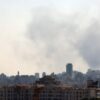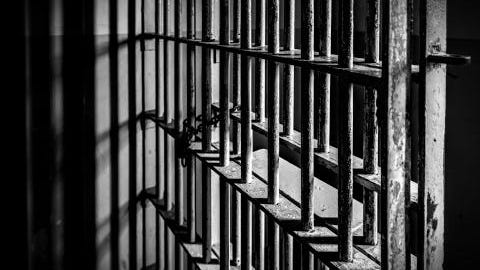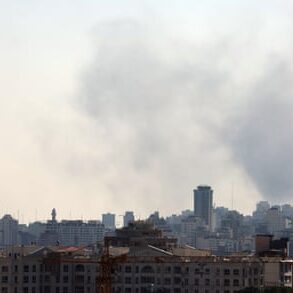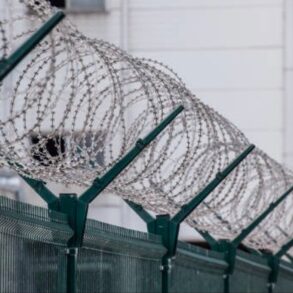President Trump announced May 4 that he is directing his administration to reopen and expand Alcatraz, the notorious former prison on an island off San Francisco, California.
In a post Sunday on his Truth Social site, Trump wrote, “For too long, America has been plagued by vicious, violent and repeat Criminal Offenders, the dregs of society, who will never contribute anything other than Misery and Suffering. When we were a more serious Nation, in times past, we did not hesitate to lock up the most dangerous criminals, and keep them far away from anyone they could harm. That’s the way it’s supposed to be.”
As the WSWS noted yesterday, Trump could well be looking in the mirror when he makes reference to “vicious, violent and repeat Criminal Offenders, the dregs of society, who will never contribute anything other than Misery and Suffering.” Under American capitalism, however, billionaire criminals live in mansions or estates: Mar-a-Lago, not Alcatraz.
Trump then indicated he is directing the Bureau of Prisons, the Department of Justice, the Federal Bureau of Investigation and Homeland Security to “reopen a substantially enlarged and rebuilt Alcatraz, to house America’s most ruthless and violent Offenders.”
“The reopening of ALCATRAZ will serve as a symbol of Law, Order and JUSTICE,” he added.
Within hours of Trump’s pronouncement, the Director of Prisons, William Marshall III, released the following statement: “I have ordered an immediate assessment to determine our needs and the next steps. USP Alcatraz has a rich history. We look forward to restoring this powerful symbol of law, order, and justice.”
The US history with the Alcatraz began in 1848 when it seized California from Mexico via the Treaty of Guadalupe Hidalgo, which ended the Mexican-American War. Alcatraz is a small 22-acre island located in San Francisco Bay, 1.25 miles off the northern shore of the city of San Francisco. It is the first land encountered by ships entering the bay through the Golden Gate.
In 1850 President Fillmore ordered that the island be set aside as a United States Military Reservation and the US Army began studying the suitability of Alcatraz Island for the positioning of coastal batteries to protect the approaches to San Francisco Bay.
The fortification ultimately led to the completion of Fort Alcatraz by 1858 that held a garrison of around 200 soldiers.
Because of the isolation created by the cold, strong currents of the waters of San Francisco Bay, in 1859 Alcatraz began to be used to house soldiers convicted of crimes.
When the Civil War broke out in 1861, it was used to imprison Confederate sympathizers and prisoners of war.
By the end of the Civil War, Alcatraz’s fortifications had become obsolete and the military changed its purpose from coastal defense to detention, a task for which it was well suited because of its isolation.
In 1867, a brick jailhouse was built (previously inmates had been kept in the basement of the guardhouse), and in 1868, Alcatraz was officially designated as a long-term detention facility for military prisoners.
Among those incarcerated at Alcatraz in the 1870s were Hopi Native American men who had who refused orders to send their children away from their families to Indian boarding schools.
In 1907, Alcatraz was officially designated as the Western U.S. Military Prison, later Pacific Branch, U.S. Disciplinary Barracks. Construction of the huge concrete main cell block was completed in 1912 and remains today as the island’s dominant feature.
During World War I, the prison was used to hold conscientious objectors, including Phillip Grosser whose pamphlet titled Uncle Sam’s Devil’s Island details his experiences.
By 1933 Sanford Bates, the director of the Bureau of Prisons. found it “an ideal place of confinement for about 200 of the most desperate or irredeemable types.”
It was formally opened as a federal penitentiary the next year and initially housed prisoners who were deemed to be the most dangerous bank robbers and murderers.
Though it was built to house a maximum of 336 prisoners, it averaged only 260-275 prisoners per year.
During the 29 years it was in use, the prison held some of the most notorious criminals in American history, including gangsters such as Al Capone, George “Machine Gun” Kelly and Robert Stroud (the “Birdman of Alcatraz) as well political prisoners such as Rafael Cancel Miranda, a member of the Puerto Rican Nationalist Party who attacked the US Capitol in 1954.
The penitentiary claimed that no prisoner successfully escaped. There were, however, a total of 36 prisoners who made a combined 14 escape attempts. Two men tried twice, 23 were caught alive, six were shot and killed during their escape attempts, two drowned, and five are listed as “missing and presumed drowned.”
The most violent incident occurred on May 2, 1946, when a failed escape attempt by six prisoners led to the Battle of Alcatraz, which lasted two days, resulting in the deaths of two guards, three inmates, the wounding of 14 others, and the later execution of two inmates for their roles in the attempted escape and the ensuing fighting.
Perhaps the most famous escape was carried out in 1962 by Frank Morris, John Anglin and Clarence Anglin. The three men are believed to have drowned in their attempt. However, no bodies were ever found, sparking speculation that they made it to shore and escaped.
The 1979 film, Escape from Alcatraz, depicts this escape, and was shown three times last weekend on a local Florida television station covering the area where Trump was spending the weekend. This has led many to speculate that seeing this film triggered Trump’s interest in reopening Alcatraz.
In 1963, a year after this latest escape attempt, Alcatraz was closed as a penitentiary. Many reasons were given, including that its operating costs were more than three times most other prisons and that a half century of saltwater saturation and caused extensive damage to many of its buildings.
On November 20,1969, a 19-month occupation of Alcatraz by Native Americans began. A group of Native American activists, led by a coalition called the Indians of All Tribes, occupied the abandoned island in protest against the US government’s policies toward Native Americans, particularly regarding land rights, treaties, and the treatment of Indigenous peoples.
The activists claimed Alcatraz based on a historic treaty that allowed Native Americans to reclaim surplus federal land. They sought to draw attention to the issues faced by Native American communities, including poverty, lack of education, and inadequate healthcare. The occupation attracted national media coverage and support from various groups, leading to increased awareness of Native American rights.
Throughout the 19-month occupation, the activists established a community, held cultural events, and engaged in negotiations with the government. However, the US government eventually demanded that the occupiers must vacate the island. The ensuing standoff ended in June 1971 when federal authorities forcibly evicted the remaining activists.
The following year the National Park Service purchased Alcatraz along with Fort Mason from the U.S. Army to establish the Golden Gate National Recreation Area.
Today, Alcatraz Island has become an iconic San Francisco attraction and important historic site. It receives about 1.6 million visitors annually and generates about $60 million in annual revenue.
Many believe that the exorbitant costs needed to build and maintain a Guantanamo Bay-type prison on Alcatraz, along with its size limitations, will prevent the realization of Trump’s proposal.
Whatever its ultimate outcome, however, Trump’s proposal to construct an American Guantanamo, within full view of one of America’s most scenic cities, is repulsive and revealing.
It would serve to normalize the construction of similar concentration like prisons throughout the country. And it is a demonstration of the fundamentally sadistic preoccupation with brutal repression as the solution to the crisis of American capitalism, shared not just by Trump but by the entire ruling class.
The Socialist Equality Party is organizing the working class in the fight for socialism: the reorganization of all of economic life to serve social needs, not private profit.
This post was originally published on this site be sure to check out more of their content.














